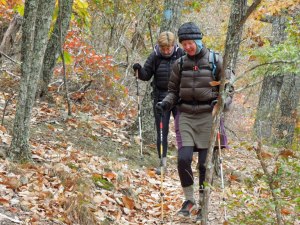I never thought I would try to dehydrate my food for backpacking.
It was so easy to go to the outfitter and buy Mountain House or some other packaged food. However, three summers ago I went on a 20 day backpacking trip—my first outing longer than 5 days.
I discovered that after eating the 4 dinners that I liked several times, the thought of having to eat any of them again gagged me. And the thought of having to eat another power bar or any other protein bar made me just want to forget about lunch.
When I was in town, I would load up on fruits and vegetables. I lost about 13 pounds on that trip and decided I had to have a better meal plan. The things that worked for a 3-5 day trip just weren’t working for a longer trip.
I needed better quality food that was better tasting and more nutritious if I was going to continue backpacking. After all I don’t really eat processed foods home nor do I eat foods that are low in nutrient density.
Dehydrating food for my meals seemed like a good place to start. I could control what went into my meals so I would have food that I liked in amounts that were satisfying to me. I have a Nesco dehydrator with 6 trays plastic sheets that I can line the trays with if I am dehydrating something like spaghetti sauce but most of the time I use parchment paper.

My favorite foods to dehydrate are:
*fruits — apples sprinkled with cinnamon, fresh pineapple slices, strawberries, and watermelon. The key is to slice the fruit evenly so that all the slices are finished at about the same time. I may do all the fruit at the same time since it uses the same temperature, but some fruits take longer. For example, a watermelon takes about 26-28 hours. Because of the sugar content of a watermelon I wrap slices in plastic wrap before putting in a Ziploc to keep the pieces from sticking. The key is to get all the moisture out. Why dehydrate fruit when they are so easily available at the grocery store? It is very hard to find fruit that does not have added sugar.
*vegetables — frozen mixed vegetables are easy to spread on a tray to dehydrate and can be added to anything. Many vegetables such as butternut squash, sweet potatoes, and acorn squash need to be cooked first. I usually roast them and then puree before spreading on a parchment paper- lined tray. Add any seasoning you like and you won’t have to carry seasonings with you. Canned black beans and kidney beans can be spread on the parchment paper to dehydrate and then use with rice for a tasty meal, especially if you remember to bring along single serving sour cream or even the powdered sour cream.
*meat — this is usually ground beef, sometimes plain but usually with taco seasoning. I can add this with any vegetable combination and some minute rice for a quick meal. I add the vegetables and rice before leaving home so I can play with herbs and spices. Beef and venison jerky are easy to make and there are a variety of recipes on the internet. It is very important to get all the moisture out or the jerky will mold.
*hummus — you can make your own or dehydrate your favorite brand. This makes a great lunch with crackers or flatbreads!
*leftovers – chili, spaghetti sauce, and hamburger stroganoff are three of my favorites and I plan to experiment with others this winter. I spread the food on parchment-lined tray and dehydrate.
Just a few things to remember:
*it takes planning to dehydrate your food but once you package it, you can toss it in the freezer until you need it
*I rehydrate each new food once at home to see how long it will take and how much water I will need. This also gives me a chance to play around with seasonings
*sometimes you will decide some foods aren’t worth it. I will never dehydrate tuna again—it is not worth the smell! Nor will I do bananas.
*your dehydrator should have various temperature settings. Fruits and vegetables need to dehydrate at 134* and meat 155*. Remember to make sure all the moisture is out
*I keep a notebook of foods that I have tried to dehydrate, the time needed to dehydrate, how much I packaged as a serving, and the amount of water need to prepare it. I write the amount of water on the package along with the contents.
I don’t get caught up in having “perfect” meals but I do want to have nutritious meals. After a day of hiking miles, pretty much anything will taste good. At the end of the day, my main goal is to have a satisfying meal that meets my nutritional needs and can be made with boiling water in less than 10 minutes with little or no clean up.
I can honestly say that this past summer I looked forward to my dinners every night of each of my backpacking trips. Now to improve my lunches!
















